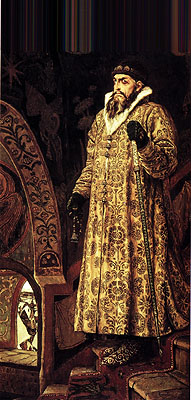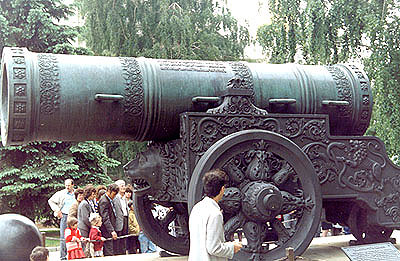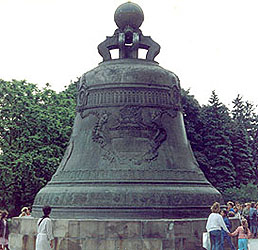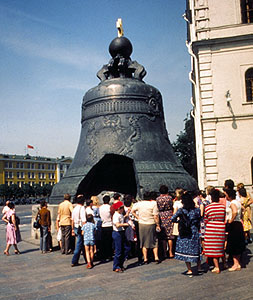It is customary when speaking about the reign of Ivan IV (1530-1584) the Terrible, to speak in terms of "good Ivan, bad Ivan," or the first, good half of his reign; then the bad, terrible, second half of his reign. But I am not sure what good, if any, was accomplished for Russia during the reign of Ivan IV. I think that what he really succeeded in doing was setting the stage for the ensuing Time of Troubles, an era marked by a complete breakdown of the country's social and national fabric. He clearly was one of the most ruthless tyrants known to history.
Some things to remember when we study Ivan IV. First, we simply do not know a lot of specifics about his childhood other than the fact that his dad died when Ivan was two and that his mother was poisoned when he was seven. This brought him under the control of the Shuiskii family. Check this out:
"The ruthless Shuiskys gradually gained more power. In 1539 the Shuiskys led a raid on the palace, rounding up a number of Ivan's remaining confidants. They had the loyal Fyodor Mishurin skinned alive and left on public view in a Moscow square. On December 29, 1543, 13-year-old Ivan suddenly ordered the arrest of Prince Andrew Shuisky, who was reputed to be a cruel and corrupt person. He was thrown into an enclosure with a pack of starved hunting dogs. The rule of the boyars had ended."
These were certainly cruel times in Russia, and it was not about to get much better. (accessed at www.xs4all.nl/~kvenjb/madrus.htm#grosny)
There were some other "turning points" in Ivan's life. In 1553, Ivan was very sick and thought that he was about to die. He asked the boyars and nobles to swear an oath of loyalty to his infant son Dmitrii, which many of them refused to do. Ivan recovered and survived; many of those princes did not (neither did the infant Dmitrii). In 1560 his first wife Anastasia died; the two had been happily married for thirteen years. Ivan was inconsolable, and he was convinced that she was poisoned. (Note that "Recent forensic tests on Anastasia's remains have revealed more than ten times the normal levels of mercury in her hair. It is likely, that Anastasia was indeed murdered."(www.bbc.co.uk/history/programmes/ivan/ivanmain.shtml)
Finally, in 1581 a disagreement with his son ended tragically when the tsar struck his son and killed him (not good).
So, you might ask, where did the tsar turn for relief? Well, after his first wife died he married an additional seven times, and this does not include all of his mistresses (most of these women did not survive very long). Ivan also became addicted to the ingestion of mercury, which he kept bubbling in small pots in his room for his consumption--Now, that surely could not have been a good idea. A later exhumation of his body showed that he suffered from mercury poisoning.
OK, I tried to make note of some "good things" about his reign, although you can easily make a reverse case for any of these.
- the "conquest" of Siberia by the Cossack Ermak Timofeevich (d. 1585)
- the capture of Kazan (1552) and Astrakhan (1554)
- first to title himself as tsar when he was crowned in 1547 at age sixteen
- his revision of the Russian law code
- the creation of a standing army armed with muskets, "the streltsy"
- the use of a council of nobles for "advice"
- the subordination of the orthodox church to the state
- the opening of the port of Arkhangelsk on the White Sea for trade with Western Europe
- the conquest of the Baltic cities Narva and Polotsk, which also allowed trade to Europe
I made a note of some bad things.
- the Livonian war (1558-1583), which involved Russia in almost continuous war with Sweden, Denmark and Poland-Lithuania for over twenty years. This proved to be an enormous drain on Russian resources--with no clear benefits--that led to the fixing of serfdom as a Russian institution.
- the oprichnina (1565)
- the terror and the unbelievably cruel tortures (Isabel De Madariaga's new book, Ivan the Terrible (2005) is just unbelievably depressing to read, page after page, account after account, of slaughters, tortures, poisonings, intrigues, executions, etc. (No wonder that Stalin so revered Ivan IV.)
- the destruction of the princely and boyar class, although you could put this into either category depending on your view
- the murder of his son (see below)




